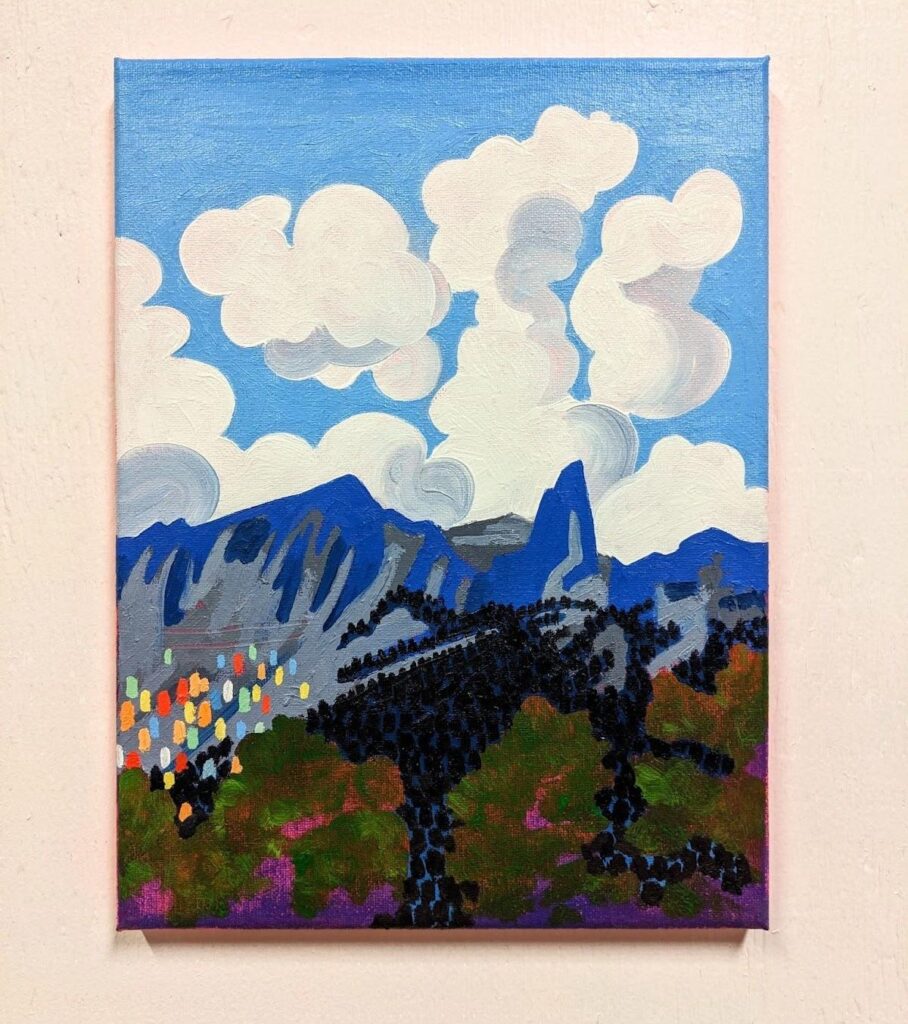By: Penny Black
Jack Bride, an emerging artist in Canada’s contemporary art scene, has unveiled a captivating new series of works deeply rooted in the landscapes of his Alberta childhood. His paintings, imbued with a unique blend of realism and evocative emotion, transport viewers to the heart of the Canadian prairies, evoking a sense of place and personal memory.
“I began painting landscapes in 2004 after graduating from what was then called The Alberta College of Art & Design,” he said. “The fine arts program was an ecosystem encouraging experimentation in media while chasing a kind of modernist purity. I was 20 years old, and the art school process felt like being uprooted from an earth I had not yet understood. Once I’d finished, I went on life drawing and landscape painting trips, yearning to capture something objectively real, if basic.”
“Returning to landscape the past few years has been like catching up with an old friend, the kind where you can pick up right where you left off without awkward formality.”

Bride’s artistic journey is inextricably linked to the vast, undulating Canadian landscape. Growing up amidst the towering badlands, the shimmering prairies, and the tranquil forests, he developed an intimate understanding of the province’s diverse natural beauty. This formative experience is the bedrock of his artistic vision. He describes his process as a meticulous exploration of light, shadow, and texture, aiming to capture not merely the visual aspects of these landscapes but the emotional resonance they hold.
Within the Canadian landscape painting, there is a long history, from Emily Carr to Lawrence Harris and the Group of Seven. Now, in 2025, artist Jack Bride conveys the sheer beauty and emotional depth of nature in Canada today. Bride’s artworks are vibrant with rich colors and striking forms, beckoning viewers to immerse themselves in the majesty of the Canadian wilderness.
Reflecting on his upbringing in Alberta, where the prairies seamlessly transition into the foothills and then the rugged Rockies, Bride says: “The diverse terrain and the striking skies of this region have been a lifelong wellspring of inspiration for my art.” He also emphasized the influence of his visits to his birthplace in Ontario, where he found inspiration in the lush, forested hills and expansive lakes that characterized the landscape.
The historical significance of Canadian landscape painting from the early 1900s is evident in the portrayal of both well-known locations and more secluded regions of the country. Bride eloquently expressed: “I perceive this rich heritage as a melodic repertoire that I have had the privilege to witness firsthand, akin to experiencing a live performance on tour.”
His artistic inspiration stems from the vibrant hues and intricate shapes present in the natural world: the captivating display of colors during sunrise and sunset, the dazzling transformation of tree leaves in autumn, and the picturesque resemblance of mountain surfaces to delicate sketches, complemented by the rhythmic arrangement of distant pine trees.
Jack Bride’s unique approach to color is a reflection of his deep connection to the ever-changing Canadian landscapes that surround him. With each brushstroke, he encapsulates the essence of the natural world, infusing his work with a vitality that goes beyond mere representation. His ability to capture the kaleidoscope of colors found in Canadian nature sets him apart as an artist who not only observes but also interprets the world around him in an intensely vibrant and captivating way.

His artistic influences drawback to influential Canadian artists, like the Group of Seven. “I can always return to Lawren S. Harris, who had a strange story arc, from painting glaciers and mountains with the Group of Seven, to holing up in high altitudes and painting the sensation of being there,” said Bride. “His later work was informed by Theosophy, an in-vogue, pre-WWI spiritualist movement in which many a bohemian dabbled. You can really see his work transform from physical landscape to psychic terrain, painting by painting.”
He is also influenced by contemporary artists like John Hartman, “who has a wonderful ability to warp the horizon, making his paintings feel like you are both hovering in the air and standing firmly on the ground,” said Bride. “He said something to the effect that everyone establishes a landscape inside themselves in early life, and as you carry on, you bring your foundational landscape with you.”
He also enjoys Attila Richard Lukacs’ landscape art. “He isn’t known as a landscape painter, which made this work odd and refreshing; he handles paint like he’s driving a tank,” said Bride.
Bride bases his landscape paintings on the iPhone photos he takes on his travels. “Lately, I’ve been seeing landscapes through my phone,” he said.
“In the beginning, I would hike haphazardly to paint on site, climbing the sheer edges of cliffs, precariously balancing my paint supplies on a sloped rock, and sleeping in small nooks at the base of hoodoos. I think I had something to prove to myself, as though I needed to earn my stripes. Luckily I survived and was never stalked by a cougar or bitten by a rattlesnake.”
He now takes pictures with his phone while he is out in nature and uses them as a reference in the studio. “I could call the process amateur remote viewing, where I conjure the feeling that I am there again and, as the painting develops, it brings me into a different place, an alternate reality of the same location,” said Bride.
“At my most traditional, I’ll go camping and do a few watercolors, then develop them into oil paintings in the studio. I think that method is still my favorite. All the senses are involved.”
Follow Jack Bride on Instagram @jack_bride_
Published by Mark V.


















